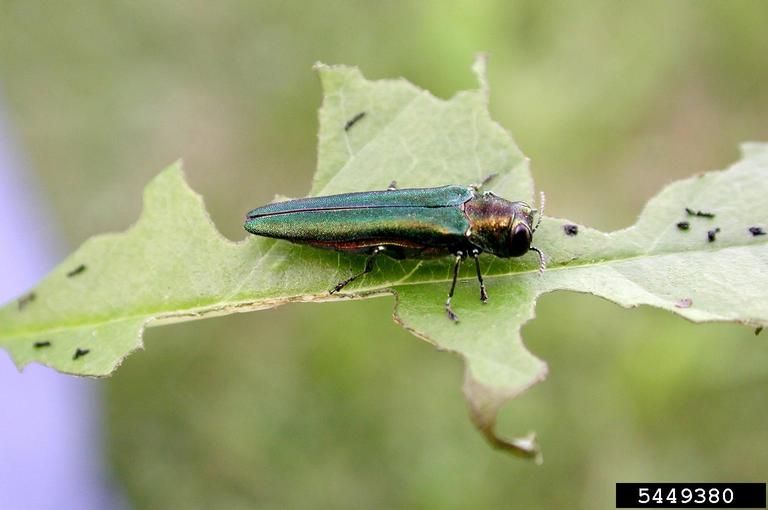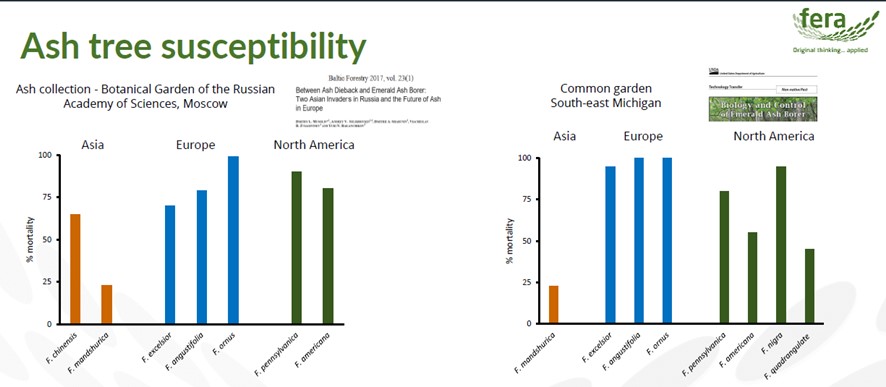Emerald Ash Borer (EAB) in Eastern Europe

-
Status of project
Ongoing -
Region
Europe -
Programme
International Plant Sentinel Network -
Workstream
Saving Plants -
Topic
Tree Conservation
As part of our commitment to combating the threat posed by the beetle Emerald Ash Borer (EAB) in the UK, the International Plant Sentinel Network (IPSN) has received funding from the UK’s plant health programme for the developing of a 3-year project (2021-2024). This funding has allowed us to spearhead preparatory work for monitoring the spread of Agrilus planipennis (EAB) in Eastern Europe.
Our efforts, have focused on monitoring and trapping for EAB in botanic gardens across the Botanic Gardens Conservation International (BGCI) network. Supported by in-country entomologists for diagnostics and scientific advice provided by Fera Science Ltd./Forest Research, we are working diligently to address this critical issue.
In the initial stages of the project, we identified and engaged 45 botanic gardens across 12 countries in Eastern Europe that house ash trees (Fraxinus spp.) in their collections. Given the varying susceptibility of ash species to EAB (see figure below), rigorous species verification took place through molecular or morphological analysis to determine the identity of at least 50 individual specimens from 11 institutions in 8 countries.

Figure: Mortality rates of different Fraxinus species when attacked by the EAB.
Knowing that trees already under stress are more susceptible to EAB infestation, we decided to also monitor for the presence of ash dieback (ADB) symptoms in selected individuals.
To facilitate this effort and ensure accessibility and effectiveness of the monitoring programme, we developed and shared ADB and EAB survey resources with participating gardens in their local languages. These resources, including posters, instructional videos, and monitoring forms, were created in collaboration with partners such as Morton Arboretum.
In spring 2021 visual survey took place, and in 2022, we conducted the first training workshop in Budapest, Hungary, as part of the Eurogard congress. This workshop provided the theoretical background information on EAB and ADB, as well as practical demonstrations on trap setup and sample extraction in garden grounds.
After providing needed materials to participating gardens (i.e. funnel traps and lures), subsequent trapping and visual monitoring occurred during the summers of 2022 and 2023, with diagnostic support provided by Fera and national entomologists. Positive findings were promptly reported to the relevant National Plant Protection Organizations (NPPO).
Map: Location of botanic gardens carrying out the EAB monitoring in 2023
Building on our experiences from previous years, a second workshop was organized in May 2023 in Kaunas, Lithuania, where updated resources for trapping and visual monitoring were shared, and practical sessions were conducted to further enhance capacity and engagement within our network.
Read more about this project in this nicely written blog: Holding back a beetle
As part of this project, the IPSN has also developed a range of resources to help support the implementation of the monitoring activities:
- EAB Trapping Manual and trap set-up video resource: s for Emerald Ash Borer (EAB) survey and trapping:
- Video guidance on how to carry out visual monitoring for EAB and Ash Dieback Disease (available in all languages of the monitoring region):
- Bulgarian: BGCI EAB Bulgarian (vimeo.com)
- Czech: BGCI EAB Czech (vimeo.com)
- Estonian: BGCI EAB Estonian (vimeo.com)
- Hungarian: BGCI EAB Hungarian (vimeo.com)
- Latvian: BGCI EAB Latvian (vimeo.com)
- Lithuanian: BGCI EAB Lithuanian (vimeo.com)
- Polish: BGCI EAB Polish (vimeo.com)
- Romanian: BGCI EAB Romanian (vimeo.com)
- Russian: BGCI EAB Russian (vimeo.com)
- Slovak: BGCI EAB Slovak (vimeo.com)
- Slovenian: BGCI EAB Slovenian (vimeo.com)
- Ukrainian: BGCI EAB Ukrainian (vimeo.com)
Thumbnail image: Debbie Miller USDA Forest Service, Bugwood org